Accurate Railroad Watches allow Trains to move Safely
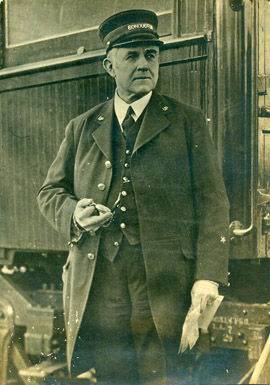 A young child walked up to a man in a dark blue uniform, standing next to a north bound train waiting to depart the depot. The child asked "excuse me sir, can you tell me what time it is?" The conductor pulled his pocket watch from his vest pocket, examined it for a few seconds, then told the child "it is 11:55." The child stood there, amazed with his large shiny watch. The conductor then added "the train will be leaving in ten minutes, just after the south bound fast mail train pulls into the depot."
A young child walked up to a man in a dark blue uniform, standing next to a north bound train waiting to depart the depot. The child asked "excuse me sir, can you tell me what time it is?" The conductor pulled his pocket watch from his vest pocket, examined it for a few seconds, then told the child "it is 11:55." The child stood there, amazed with his large shiny watch. The conductor then added "the train will be leaving in ten minutes, just after the south bound fast mail train pulls into the depot."
A few minutes earlier the conductor had checked his pocket watch against the depot "standard clock," as had the engineer in the locomotive at the front of the train, they knew that the safety of the passengers depends on all train crews accurately knowing what time it is, according to railroad time. The railroad had developed strict standards requiring reliable high grade watches being used by railroad workers, and workers were required to have these watches inspected twice each month to ensure they were in good working condition, even small errors could result in the loss of life and property. In past years several major accidents occurred because of differences in perceived time of just a few minutes.
As the new railroads were being built trains were typically operated on a single track, including those going in opposite directions, with sidings provided at intervals to allow trains to pass each other. Railroads operated using a timetable in order to avoid collisions between trains and to move trains efficiently over the railroad lines. A timetable is a published schedule of the movement of trains which lists the trains, locations along the railroad line, and times at which certain events, such as arrivals and departures at a station or siding, are expected to take place. Most railroads specified a time interval to allow trains time to pull in and out of sidings and stations.
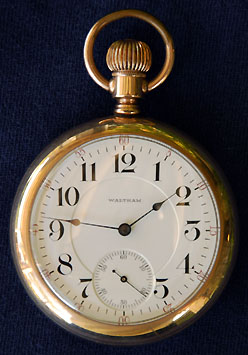 In the early years, reliable watches were expensive. Railroad companies differed in their approach to this problem.
There is documentation that as early as 1850, the Boston and Providence Railroad ordered 45 English watches, from Bond & Son, Boston. The Pennsylvania Rail Road also purchased pocket watches and published the
rule: "Each
engineer will be furnished with a watch which shall be regulated by the
Station Agent at the commencement of each trip and must be deposited
with him when the engine returns. If not
returned in as good order as it was received, the Engineer must pay
the expense of repairs." Conductors furnished their own watches.1
In the early years, reliable watches were expensive. Railroad companies differed in their approach to this problem.
There is documentation that as early as 1850, the Boston and Providence Railroad ordered 45 English watches, from Bond & Son, Boston. The Pennsylvania Rail Road also purchased pocket watches and published the
rule: "Each
engineer will be furnished with a watch which shall be regulated by the
Station Agent at the commencement of each trip and must be deposited
with him when the engine returns. If not
returned in as good order as it was received, the Engineer must pay
the expense of repairs." Conductors furnished their own watches.1
Nevertheless, the concept of controlling the quality of the watches had merit. By 1853, the Boston & Providence Railroad may have given up on the ownership of watches, but not the concept of controlling their quality. In August 1853 The Boston & Providence Railroad published Standard Time rules, including:
- All Conductors of Passenger and Freight trains will compare their time with Station time, Boston and Providence, every day, and report any variations to Superintendent of Transportation.
- A record will be made by the Ticket Clerk, or in his absence, by the Baggage Master, of the comparisons required by Art. 5 to which they will certify by their signature or initials.
- Conductors will submit their watches to Bond & Sons, 17 Congress street, Boston, for examination, and procure from them a certificate of reliability which will be handed to the Superintendent.
- Conductors will report to Messrs. Bond any irregularity in the movements of their watches, and they will clean, repair and regulate them, at the expense of the Corporation, furnishing Conductors with reliable watches in the interim.2
American Watch Manufacturing Industry Emerges
During the 1840's and 1850's American watch manufactures had began experimenting with with using machines to make watches with interchangeable parts. 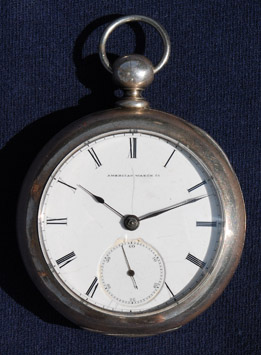 Edward Howard and Aaron Lufkin Dennison would eventually perfect and patent their precision watch making machines and create the American System of Watch Manufacturing. The first Dennison, Howard, & Davis watches were made in 1850, but problems were encountered. It was not until 1853 that the first watches were offered for sale to the public.
Edward Howard and Aaron Lufkin Dennison would eventually perfect and patent their precision watch making machines and create the American System of Watch Manufacturing. The first Dennison, Howard, & Davis watches were made in 1850, but problems were encountered. It was not until 1853 that the first watches were offered for sale to the public.
Some of the earliest high quality American machine-made watches went right into railroad service. The American Watch Co. furnished some model 1857 Appleton, Tracy & Co. watches to the P.R.R. in 1866 and the Elgin National Watch Company B.W. Raymond, built in 1867, also saw service on the Pennsylvania Railroad. These two were typical of watches used in railroad time service on those roads specifying watches of a certain minimum quality.
Not all railroad companies had the same requirements. In the early years on some railroads only the conductor carried a pocket watch, sometimes furnished by the company, eventually the conductor and engineer were both required to carry a pocket watch and were expected to compare times periodically.
Standardization of watch sizes also allowed the internal watch movements to be sold to the local watchmakers or jewelry stores separately from the cases, allowing the railroad workers to select a watch movement with the case design and manufacture of their choice.
By 1870 additional American watch manufactures had started marketing high quality watches suitable for railroad use, along with less precise lower priced watches for general use. American made 18-size, 15-jewel, patent regulator, "adjusted" pocket watches in both hunting and open face cases dominated railroad service during the later part of nineteenth century. For more information see American Watch Manufactures.
Inaccurate watches can lead to accidents
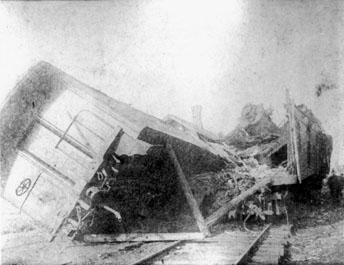 Inaccurate watches created differences in perceived time, sometimes leading
to accidents. While only a small percentage of train wrecks were due to inaccurate watches, several horrible train accidents pointed
out that the nation's railroads were not all running on reliable timepieces.
Inaccurate watches created differences in perceived time, sometimes leading
to accidents. While only a small percentage of train wrecks were due to inaccurate watches, several horrible train accidents pointed
out that the nation's railroads were not all running on reliable timepieces.
A head-on train collision occurred on April 18, 1891 on the Lake Shore and Michigan Southern Railway at Kipton, 40 miles west of Cleveland, Ohio, which made headlines across the country. The Fast Mail train No. 14 was heading East. On the same track passenger train, No. 21 the Toledo Express, was heading West. The engineer and conductor of the westbound passenger train were given written train orders near Elyria to let the eastbound fast mail train pass them at Kipton, a small station west of Oberlin. The passenger train engineer was told that fast mail train was running on time as they left Elyria, also on time, according to the engineer's pocket watch. The two trains collided head-on at Kipton, the passenger train was under full brakes just about to pull into the siding, but the fast mail was at full speed, the passenger train hadn't made it into the Kipton siding on time. Both engineers, the passenger train fireman and six postal clerks were reported killed. the fast mail fireman and one other person were seriously injured. Both engines, three mail cars and one baggage car were reported completely wrecked. US Post Office also sustained great property losses.
The official report stated that not enough time was allowed for the passenger train train to get into the siding.3 Many contemporary accounts quote Webb C. Ball, Cleveland, Ohio jeweler who was appointed by the Lake Shore and Michigan Southern Railway to investigate time keeping issues on the line following the collision, from an copyrighted interview by James B Morrow in 1910, citing the engineer's who's watch had stopped for 4 minutes, then started again as the cause of the accident, differing from the original report.
Other accidents were linked to inaccurate watches, some of which also resulted in fatalities including:
| August 9, 1853 | Camden & Amboy | Old Bridge, New Jersey | 4 killed | Engineer's watch 2.5 minutes slow |
| August 12, 1853 | Providence & Worcester | Valley Falls, Rhode Island | 14 killed | Conductor's watch 2 minutes slow |
| August 1878 | Panhandle | Mingo Junction, Ohio | 18 killed | Conductor's watch 20 minutes slow |
| November 1882 | Illinois & St. Louis | Belleville, Illinois | 2 killed | watch 54 minutes slow |
| November 1893 | Hocking Valley | Bradner, Ohio | 4 killed | Engineer's watch 17 minutes slow4 |
A railway conductor was indicted for manslaughter in connection with the Mingo Junction accident in which it was determined his pocket watch was incorrect.
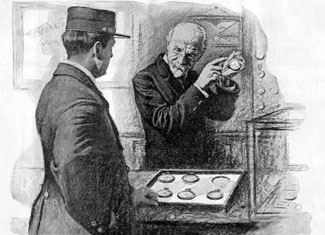 Railroad Watch Inspection Ensures Accuracy
Railroad Watch Inspection Ensures Accuracy
In order to ensure accuracy and facilitate safe railroad operation almost all railroads required periodic watch inspection. In September 1853 Boston & Providence Superintendent Raymond Lee asked William Boyd & Son of Boston to examine all the company owned and privately owned watches in use on his railroad and provide a certificate for each indicating if it was "fit to be trusted or not." Watches found to be deficient would be repaired at company expense. Lee later had Bond order 45 Barraud & Lund watches from London.5
John C. Adams, one of the pioneers of the watch making industry in the United States was appointed time keeper for all the railroads centering in Chicago in 1862, while in charge of the watch department of the Chicago firm W. H. & C. Miller Co.6 Adams initially selected "quick train watches with going barrels" from James Hoddell of London for railway use.
During the 1880's, more railroad companies had established standards and some had listed approved models, such as Waltham's 1883 model Crescent Street Grade and Elgin's B. W. Raymond. Beginning in 1885 the General Time Convention worked to develope a Standard Code of Railroad Operating Rules, an industry code that is still in use. They began their work by sending questionnaires to member railroads. In April 1887 the General Time Convention adopted Rule 16 of the Standard Code:
"Each conductor and engineman must have a reliable watch, which has been examined and certified to on the form attached hereto, by a responsible watchmaker. Conductors and enginemen entering service must file such a certificate before they are allowed to take charge of trains or engines; and watches must be examined, and certificates renewed, every six months."
The certificate referenced specified "variation not to exceed thirty seconds per week." While adherence to the Standard Code was voluntary, it represented best operating practices for the 1880's and was based on rules already in use by various railroad companies.
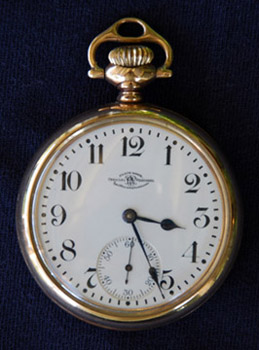 J. C. Adams also developed the Adams' System of Time Records which was first put into operation on the Atchison. Topeka & Santa Fe in 1888. The Denver & Rio Grande, Union Pacific, Southern Pacific and other roads also adopted Adams' system. A license or certificate was issued to each watchmaker who was appointed an inspector. The inspector was provided time via wire from the railroad. He was furnished with a record book and monthly report cards, every conductor and engineer was required to bring his watch to the inspector for examination. At the end of the month the completed report cards were forwarded to the division superintendent and new report cards were issued.7
J. C. Adams also developed the Adams' System of Time Records which was first put into operation on the Atchison. Topeka & Santa Fe in 1888. The Denver & Rio Grande, Union Pacific, Southern Pacific and other roads also adopted Adams' system. A license or certificate was issued to each watchmaker who was appointed an inspector. The inspector was provided time via wire from the railroad. He was furnished with a record book and monthly report cards, every conductor and engineer was required to bring his watch to the inspector for examination. At the end of the month the completed report cards were forwarded to the division superintendent and new report cards were issued.7
Webb C. Ball, a Cleveland jewelry store owner, was Chief Time Inspector and developed a time inspection system for railroads centered in the Cleveland area. A January 1891 advertisement listed Ball as the "Official Watch Inspector and Time keeper" for six railroads. Ball was among the first jewelers to use the Standard Time service provided by the Washington Observatory. Webb C Ball was commissioned by the Lakeshore and Michigan Southern Railway as their Chief Time Inspector following the 1891 fatal collision near Cleveland. Ball was asked to investigate "time and watch" conditions throughout the line. Ball required watch inspection every two weeks and rejected watches which did not meet standards in order to ensure accuracy and facilitate safe railroad operation.
Ball built an organized watch inspections system which grew into the Ball Railroad Time Service to ensure watch accuracy on a number of railroads. The actual inspectors were the same jewelers who were Ball Watch Co. dealers to whom Ball was distributing watches and jewelry. According to Ball in a copyrighted interview by James B Morrow in 1910, his service grew to control the inspection of watches railmen used on 125,000 miles or railroad lines, about half of the U.S.'s railroads, although the accuracy of this statement has been questioned. Ball also promoted nationwide acceptance and adoption of the new General Railroad Timepiece Standards and was honored for his accomplishments by the Brotherhood of Locomotive Engineers.
In addition to J. C. Adams' and Webb C. Ball's companies, other companies which provided watch inspection services to railroads on a contract basis included Giles, Bro. & Co. (a Chicago jeweler), J.W. Forsinger and the J.W. Forsinger Watch Inspection Service (Chicago), American Railroad Time Service Co., National Railway Time Service Co. and J.H. Mace Co. Some railroads, including the Atchison Topeka & Santa Fe, Baltimore & Ohio, Canadian Pacific and Southern Pacific either already had or developed their own time service.
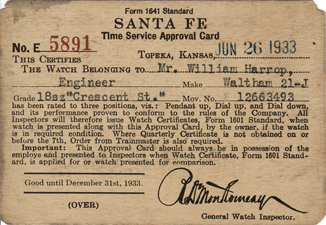 Railroaders under time service rules had to bring their watches to the inspector, who would compare it to a standard clock to ensure it remained accurate, typically either twice a month, or every other week depending on the specific railroad's rules. On many railroads the conductors and engineers were issued a small watch card (certificate) to record the watches performance, watch's deviation from standard time would be noted. If a watch fell behind or gained more than 30 seconds in 7 to 14 days it had to be sent in for
repair. Railroaders were prohibited from setting their watches unless it was an emergency.
Railroaders under time service rules had to bring their watches to the inspector, who would compare it to a standard clock to ensure it remained accurate, typically either twice a month, or every other week depending on the specific railroad's rules. On many railroads the conductors and engineers were issued a small watch card (certificate) to record the watches performance, watch's deviation from standard time would be noted. If a watch fell behind or gained more than 30 seconds in 7 to 14 days it had to be sent in for
repair. Railroaders were prohibited from setting their watches unless it was an emergency.
Watches were typically required to be more thoroughly inspected every six months, and cleaned by a jeweler every 12 to 18 months to ensure that they all remained accurate, Santa Fe, for example required watches to be cleaned within 15 months of the last cleaning. Some railroads required time service approval certificates be issued after a watch was cleaned and tested. Loaner watches were provided by jewelers while a watch was in for cleaning or repair.
General Railroad Timepiece Standards Created
The railroad industry was called upon to create standards for watches which all railroads would eventually follow. By 1893 the General Railroad Timepiece Standards Commission presented new guidelines, referred to as the General Railroad Timepiece Standards, which required watches in use by employees responsible for train movement meet the following recommended minimum standards:
- Be open face (no lid over the dial), size 18 or 16 (Lancashire Gauge for measuring watches, as measured at the dial plate, size 18 equals 1 23/30" or 44.86 mm, size 16 equals 1 11/16" or 43.18 mm, more about watch sizes)
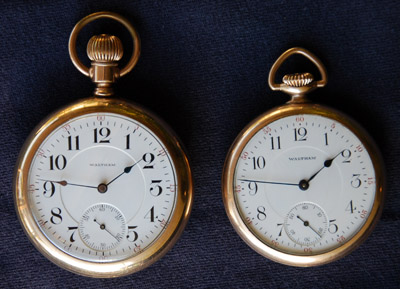 Plain white dial, bold black hands, and bold Arabic numbers
Plain white dial, bold black hands, and bold Arabic numbers- Have the winding stem at 12 o'clock
- Be lever set (to set the time, the case had to be opened, lever pulled out to set the hands, to prevent an accidental change, rather than pendant set)
- Have a minimum of 17 jewels, a double roller, steel escape wheel, micrometric regulator and grade on back plate
- Be adjusted to at least 5 positions (stem up, left side up, right side up, face up and face down)
- Temperature compensated for 34 to 100 degrees Fahrenheit
- Keep time accurately to within a gain or loss no more than than 30 seconds a week.
The goal of these standards was to ensure watches used on the railroads would be reliable, easy to read and accurate. Almost all railroads eventually adopted the new standards. Only approved railroad grade watches meeting these standards were allowed, however, older railroad grade pocket watches already in service which met the older standards could continue to be used on many railroads, as long as they were in first-class condition and continued to meet the 30 second per week requirement.
Following the adoption of the 1893 General Railroad Timepiece Standards, watch manufactures designed watches to meet the new railroad standard requirements. It should be pointed out that many of railroads did not adopt all of these recommended standards for another decade. In publishing watch requirements railroads commonly continued to accept roman numerals on dials, open-face pendant-set watches and a minimum of 15-jewels watches, until 1906-1908. Some railroads continued to accept hunting case watches with hunting case movements into the 1920's. Watches adjusted to 3 positions, rather than the recommended 5 positions, were generally accepted in railroad service until around 1907, with some railroads including the ATSF continuing to accept them into the 1920's.
Train dispatchers, conductors, enginemen, brakemen, yardmasters and foremen of yard engines were required to equip themselves with approved railway standard watches. Conductors and enginemen were always to compare their watches before starting on a run or before commencing work each day, other members of the train crew must compare their watches with the conductor's or engineman's watch at the first opportunity.
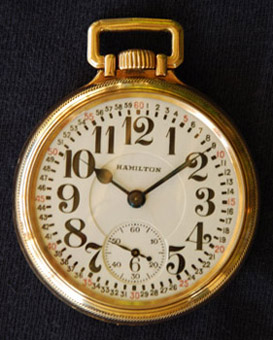 Railroad Watch Standards Evolve
Railroad Watch Standards Evolve
Watch standards continued to evolve as railroad grade watch manufacturing quality improved and trains got faster. By the first decade of the new century new smaller model "16-size" watches began to appear in significant quantities. Requirements for new watches to be used in railroad service changed - eventually only open-face watches were allowed, fewer 18-size movements were allowed, and the minimum number of jewels needed to be increased. By 1920 production of 18-size railroad grade movements had ended. The constant in all of this was that railroad watches needed to maintain a standard of timekeeping of less than 30 seconds of error over a week. Many older watches were grandfathered as long as they were able to meet this standard, even if they were technically obsolete, policies for older watches varied from railroad to railroad and from decade to decade.
The Santa Fe Railway published new requirements for a standard watch effective May 15, 1921 as follows: Seventeen (or more) jewels, lever setting, adjusted to three positions, pendant up, dial up and dial down; adjusted to temperature and isochronism; Breguet hair-spring; steel escape wheel; double-roller escapement. Movements were to be carried in an open face case, with the winding stem at "12" (hunting cases were no longer accepted). Non-breakable glass was not permitted. Watches must be regulated to perform within a limit of error not exceeding thirty seconds per week. Watches currently in service that conformed to the previous standards could continue to be used as long as they remained in first-class condition.
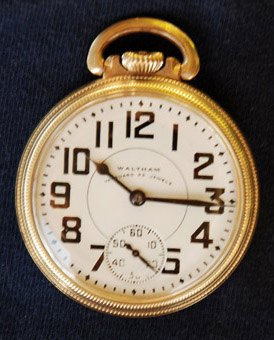 R. D. Montgomery, General Watch Inspector for the Santa Fe Railway specified regulation for new watches designated as of 1929 to be standard is described as follows: "16 size, American,
lever-setting, 19 jewels or more, open face, winding at "12", double
roller escapement, steel escape wheel, adjusted to 5 positions, temperature
and isochronism, which will rate within a variation not exceeding more than 6 seconds in 72 hour tests, pendant
up, dial up, and dial down, and to be regulated within a variation not exceeding
30 seconds per week". Like other railroads, the Santa Fe updated its list of approved watches each year.
R. D. Montgomery, General Watch Inspector for the Santa Fe Railway specified regulation for new watches designated as of 1929 to be standard is described as follows: "16 size, American,
lever-setting, 19 jewels or more, open face, winding at "12", double
roller escapement, steel escape wheel, adjusted to 5 positions, temperature
and isochronism, which will rate within a variation not exceeding more than 6 seconds in 72 hour tests, pendant
up, dial up, and dial down, and to be regulated within a variation not exceeding
30 seconds per week". Like other railroads, the Santa Fe updated its list of approved watches each year.
As diesel locomotives began to be used during the 1940's, newer railroad grade watches with a non-magnetic hairspring became required.
Wrist Watches Approved for Railroad Use
During the later part of the Nineteenth century wrist watches, also then known as wristlet watches, were designed for use by women. Because of their small size few believed wristlets could be made to achieve any level of accuracy. Twentieth century warfare depended on tactical timing, and pocket watches were difficult to remove from a pocket to read while in combat. During World War 1 (WWI) soldiers were given wrist watches, often referred to as trench watches, which could be more easily read when the soldiers hands were full. These watches were made with pocket watch movements that were adapted to be strapped to a soldiers wrist. After the war the more convenient wrist watches became popular for civilian use, with wrist watch sales dominating watch sales to the general public by 1930.
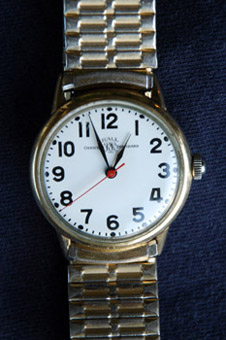 Railroad grade pocket watches remained the only watches approved for railroad service until the late 1950's when railroad
grade wrist watches were developed that could maintain the same accuracy. The "Trainmaster" with a Swiss made 21 jewel movement, introduced by Ball in 1959 and the "B.W. Raymond" with a 23 jewel American made movement, introduced by Elgin in 1960, were both high grade manual-wind wrist watches that were gradually approved for use on most American railroads. Ball later added a 25-jewel self-winding version of the watch.
Railroad grade pocket watches remained the only watches approved for railroad service until the late 1950's when railroad
grade wrist watches were developed that could maintain the same accuracy. The "Trainmaster" with a Swiss made 21 jewel movement, introduced by Ball in 1959 and the "B.W. Raymond" with a 23 jewel American made movement, introduced by Elgin in 1960, were both high grade manual-wind wrist watches that were gradually approved for use on most American railroads. Ball later added a 25-jewel self-winding version of the watch.
In 1962 Bulova introduced a railroad-approved version of their Accutron tuning-fork wrist watch using an electronic "214" movement. Hamilton also produced a railroad electric wrist watch using a Hamilton 505 movement which was briefly approved for use on some railroads, although it was later withdrawn due to issues with reliability.
By 1950 imported Swiss watches had become popular in the United States. The Waltham Watch Company founded a subsidiary in Switzerland in 1954, but Waltham ultimately went out of business in 1957. Elgin discontinued watch manufacturing in the US in 1968. The last American railroad pocket watch was the grade 992B sold by the Hamilton Watch Co. in 1969.
SEIKO introduced wrist watches with a quartz movement in the early-1970's. The inherent accuracy and low cost of production has resulted in the proliferation of quartz clocks and watches since that time. Today railroad employees can purchase SEIKO, Citizen, Pulsar and Invicta quartz wrist watches with railroad approved dials.
The Ball Watch Co. was family owned by direct descendants until the 1990s when the right to use the name was sold. The new firm continues to sell Ball watches, using Swiss-made (primarily ETA) high grade mechanical movements designed for sportsmen and railroads workers. The Ball product line continues to include Official Railroad Watches, perpetuating the traditions of the early BALL timekeepers.
Watches in Railroad Service Today
Today the use of radios, automatic block signals, and central computer tracking of trains has lessened the role of the railroad watch on many railroads, yet watch requirements still remain important to safe railroad operation. 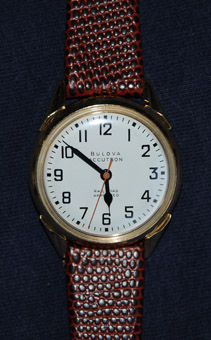 On the Union Pacific, for example:
On the Union Pacific, for example:
Rule 1.48 Time: While on duty, crew members must have a watch. Other employees must have access to a watch or clock.
The watch or clock must:
• Be in good working condition and reliable.
• Display hours, minutes, and seconds.
• Not vary from the correct time by more than 30 seconds.
• Be compared with the time source designated in special instructions.
For more information about which watches were approve for railroad use, see list of approved watches.
1 "Rules for Passenger Engine Men," Rules and Regulations for the Government of the Transportation Department of the Pennsylvania Rail Road, 1949, reprinted in "Railroad Timekeepers" Ian Bartky, NAWCC Bulletin No. 262, October 1989.
2 Bartky, Ian R. Selling The True Time, Nineteenth-Century Timekeeping in America, Stanford University Press, Stanford, CA, 2000, pg. 29
3, 4, 5 Bartky, Ian R. "Railroad Timekeepers" NAWCC Bulletin No. 262, October 1989, pp 399-411.
6 Higginbotham, Chas. T., "Railroad Time Inspection" Rock Island Employes Magazine, February 1911, pp. 33-34.
7 "Railroad Watch Inspection and Adams' System of Time Records", The Jewelers Circular-Weekly and Horological Review, July 28, 1987, pp. 33-34.
Railroad Time Railroad Clocks Railroad Watches Approved Watches Watch Use & Care Watch Manufactures
Sharing A Heritage Railroad History Train Technology Railroad Operation Railroad Time Museums & Heritage Railroads Railroads Today
